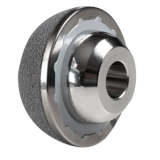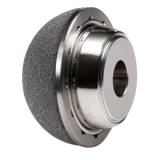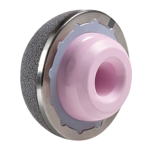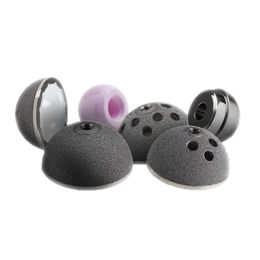Product Description
The power to meet a wide variety of individual patient needs.
Zimmer® Continuum Acetabular System provides highly flexible solutions for orthopedic surgeons who treat a wide range of patients. The system combines the biologic ingrowth of Trabecular Metal™ Technology with Zimmer® advanced bearing options. With one of the most comprehensive systems, surgeons have the ability to address variations of anatomy and choose the bearing technology that best meets the needs of each patient.
- Highly porous Trabecular Metal® material with over 12 years of clinical history
- Designed to Provide Initial Stability
- 0.98 coefficient of friction*
- Creates an excellent initial scratch fit, reduces micromotion to support better biologic ingrowth
- This initial stability helps reduce the need for supplemental screws or ancillary fixation
* For non-machined surfaces.
- Trabecular Metal material characteristics
- Up to 80% porosity
- Nearly 100% open-pore structure and up to 80% porosity
- Allows for more biologic ingrowth
- Trabecular Metal Acetabular Shells have over 12 years of clinical history1,2
- Trabecular Metal Implants have over 12 years of clinical history, with more than 75 peer-reviewed journal publications
- Power to choose advanced bearing technologies to match patient demands
- Longevity® Highly Cross-linked Polyethylene is highly resistant to wear and aging with over ten years of clinical history1-11
- Metasul® Metal-on-Metal Material has a very low wear rate with over twenty years of clinical history12
Product Brochure
References
- Data on file at Zimmer.
- Medel FJ, Kurtz SM, MacDonald DW, et al. First-generation highly crosslinked polyethylene in THA: clinical and material performance. 55th Annual Meeting of the Orthopaedic Research Society Las Vegas, 2009.
- Kärrholm J, Five to seven years experiences of highly crosslinked PE. Abstract number 19059, SICOT Hong Kong, August 2008.
- McCalden RW, MacDonald SJ, Rorabeck CH, Bourne RB, Chess DG, Charron KD, Wear Rate of Highly Crosslinked Polyethylene in Total Hip Arthroplasty. A Randomized Controlled Study, J Bone Joint Surg Am. 2009; 91: 773-82.
- Bragdon, CR, et al., Seven to Ten Year Follow-Up of Highly Crosslinked Polyethylene Liners in Total Hip Arthroplasty, Poster No. 2444, 55th Annual Meeting of the Orthopaedic Research Society, Las Vegas, 2009.
- Wannomae KK, et al., In vivo oxidation of retrieved crosslinked ultra-high molecular-weight polyethylene acetabular components with residual free radicals, J Arthroplasty. 2006; 21(7): 1005-1011.
- Collier JP, et al., Comparison of cross-linked polyethylene materials for orthopaedic applications, Clin Orthop. 2003; 414: 289-304.
- Bhattacharyya S et al., Severe In Vivo Oxidation in a Limited Series of Retrieved Highly-Crosslinked UHMWPE Acetabluar Components with Residual Free Radicals, 50th Annual Meeting of the Orthopaedic Research Society, Paper 0276, Las Vegas, 2004.
- Jibodh, SR, et al., Minimum Five Year Outcome and Wear Analysis of Large Diameter Femoral Heads on Highly Crosslinked Polyethylene Liners, Poster No. 2445, 55th Annual Meeting of the Orthopaedic Research Society, Las Vegas, 2009.
- Bragdon CR, et al., Minimum 6-year Follow up of Highly Crosslinked Polyethylene in THA, Clin Orthop. December 2007; (465): 122-127.
- Digas et al., Crosslinked vs. Conventional Polyethylene in Bilateral Hybrid THR Randomised Radiostereometric Study, 50th Annual Meeting of the Orthopaedic Research Society, Poster No. 0319, Las Vegas, 2004.
- Rieker CB, Schön R, Köttig P, et al. Development and validation of a second-generation Metal-on-Metal bearing: laboratory study and analysis of retrievals, J Arthroplasty. 2004;19 (8, suppl 3): 5-11.
Indications
The system is indicated for:
- Primary or revision surgery in skeletally mature individuals for rehabilitating hips damaged as a result of noninflammatory degenerative joint disease (NIDJD) or its composite
- Diagnoses of osteoarthritis, avascular necrosis, protrusio acetabuli, traumatic arthritis, slipped capital epiphysis, fused hip, fracture of the pelvis, and diastrophic variant
- The system is intended for use either with or without bone cement in total hip arthroplasty
Contraindications
This device is contraindicated for the following:
- Osteoradionecrosis
- Neuromuscular compromise, vascular deficiency, or other conditions in the affected limb that may lead to inadequate skeletal fixation
- Systemic or local infection
- Allergy to the implanted material









